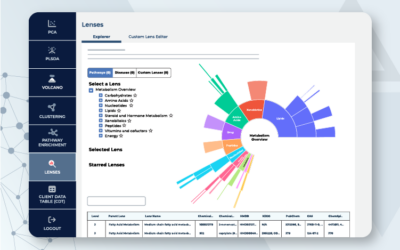Metabolon’s platform and services have contributed to over 3,000 publications.. In January alone of this year, our data was used in 28 metabolomics citations, one of which appeared in Nature Genetics. The topics range from COVID-19 to inflammation; the species studied include sea urchins and cows. Where will our data help you publish next?
COVID
- Urine-based multi-omic comparative analysis of COVID-19 and bacterial sepsis-induced ARDS
Batra R, Uni R, Akchurin OM, et al. Urine-based multi-omic comparative analysis of COVID-19 and bacterial sepsis-induced ARDS. Mol Med. 2023;29(1):13. Published 2023 Jan 26. doi:10.1186/s10020-023-00609-6
Description: This study demonstrates the comparison of two acute respiratory distress syndrome (ARDs) etiologies. Overall, this study identified metabolites and proteins that were differentially abundant between the two groups. The results provided more evidence for significant molecular differences in ARDS patients from different etiologies and a potential synergy of extracellular matrix molecules, inflammation, and mitochondrial dysfunction in ARDS pathogenesis.
HEART
2. Antibiotic-induced gut microbiota depletion exacerbates host hypercholesterolemia
Kappel BA, De Angelis L, Puetz A, et al. Antibiotic-induced gut microbiota depletion exacerbates host hypercholesterolemia. Pharmacol Res. 2023;187:106570. doi:10.1016/j.phrs.2022.106570
Description: This study clarifies the connection between gut microbiota and host cholesterol metabolism.
3. Dietary essential amino acids for the treatment of heart failure with reduced ejection fraction
Ragni M, Greco CM, Felicetta A, et al. Dietary essential amino acids for the treatment of heart failure with reduced ejection fraction [published online ahead of print, 2023 Jan 10]. Cardiovasc Res. 2023;cvad005. doi:10.1093/cvr/cvad005
Description: This study shows how metabolic alterations and energy production deficits are hallmarks of and suggests therapeutic targets for heart failure. Biochemical, molecular, and genetic approaches suggest that the renormalization of branched-chain amino acid oxidation in cardiac tissue could play a significant role in counteracting these deficits.
4. Metabolomic Signatures Associated with Pulmonary Arterial Hypertension Outcomes
Pi H, Xia L, Ralph DD, et al. Metabolomic Signatures Associated With Pulmonary Arterial Hypertension Outcomes. Circ Res. 2023;132(3):254-266. doi:10.1161/CIRCRESAHA.122.321923
Description: This study investigates metabolic features and pathways associated with right ventricular (RV) dilation, mortality, and measures of disease severity that can provide insight into molecular mechanisms, identify subphenotypes, and suggest potential therapeutic targets. Overall, polyamine, histidine, and sphingomyelin metabolic pathways represent promising candidates for identifying patients at high risk for poor outcomes and investigating their roles as markers or mediators of disease progression and RV adaptation.
5. Identification of PCSK9-like human gene knockouts using metabolomics, proteomics, and whole-genome sequencing in a consanguineous population
Belkadi A, Thareja G, Abbaszadeh F, et al. Identification of PCSK9-like human gene knockouts using metabolomics, proteomics, and whole-genome sequencing in a consanguineous population. Cell Genom. 2022;3(1):100218. Published 2022 Nov 15. doi:10.1016/j.xgen.2022.100218
Description: This study demonstrated that rare loss-of-function variants are more likely to be found in the homozygous state in consanguineous populations, and deep molecular phenotyping of blood samples from homozygous carriers can help to discriminate between silent and functional variants. Overall, this demonstrated that the chances of finding such variants are about 168 times higher in the Qatar Biobank (QBB) compared with GnomAD and emphasizes the potential of using consanguineous populations for drug discovery.
INFLAMMATION
6. Short-term feeding of defatted bovine colostrum mitigates inflammation in the gut via changes in metabolites and microbiota in a chicken animal model
Elsasser TH, Ma B, Ravel J, Kahl S, Gajer P, Cross A. Short-term feeding of defatted bovine colostrum mitigates inflammation in the gut via changes in metabolites and microbiota in a chicken animal model. Anim Microbiome. 2023;5(1):6. Published 2023 Jan 26. doi:10.1186/s42523-023-00225-z
Description: This metabolome analysis revealed that anti-inflammatory metabolites were significantly greater in abundance in bovine colostrum (BC)-fed animals. A repeated design, iterative multiple regression model was developed to analyze how BC affected anti-inflammatory metabolite abundance coincident.
7. Consequences of collagen induced inflammatory arthritis on circadian regulation of the gut microbiome
Simpkins DA, Downton P, Gray KJ, et al. Consequences of collagen induced inflammatory arthritis on circadian regulation of the gut microbiome. FASEB J. 2023;37(1):e22704. doi:10.1096/fj.202201728r
Description: This article highlights how experimental inflammatory arthritis leads to a re-organization of circadian rhythmicity in both the gut and associated microbiome. The study was performed on mice with collagen induced arthritis that exhibited extensive changes in rhythmic gene expression in the colon and reduced barrier integrity. Overall, these findings highlight that altered circadian rhythmicity during inflammatory disease contributes to the dysregulation of gut integrity and microbiome function.
8. Plasma metabolic profiling implicates dysregulated lipid metabolism and glycolytic shift in hyperinflammatory ARDS
Alipanah-Lechner N, Neyton L, Mick E, et al. Plasma metabolic profiling implicates dysregulated lipid metabolism and glycolytic shift in hyperinflammatory ARDS [published online ahead of print, 2023 Jan 17]. Am J Physiol Lung Cell Mol Physiol. 2023;10.1152/ajplung.00278.2022. doi:10.1152/ajplung.00278.2022
Description: This study investigates whether plasma metabolites differed amongst patients with latent class analysis (LCA)-derived hyperinflammatory and hyperinflammatory ARDS. Findings show that metabolic profiling offers prognostic information beyond what is captured by LCA phenotypes alone. Deeper biologic profiling may identify key differences in pathogenesis among patients with ARDS and lead to novel targeted therapies.
DIABETES AND OBESITY
9. A comparison of associations of body mass index and dual-energy x-ray absorptiometry measured percentage fat and total fat with global serum metabolites in young women
Dorgan JF, Ryan AS, LeBlanc ES, et al. A comparison of associations of body mass index and dual-energy x-ray absorptiometry measured percentage fat and total fat with global serum metabolites in young women. Obesity (Silver Spring). 2023;31(2):525-536. doi:10.1002/oby.23619
Description: This study evaluated the usefulness of BMI as a measure of adiposity in serum metabolomics studies. Findings show that metabolite set enrichment analysis identified diacylglycerol and sphingolipid metabolism as overrepresented among metabolites significantly correlated with BMI, percent fat, and total fat.
10. A multiomic approach to examine the molecular signatures differentiating people with obesity alone from those with obesity and metabolic complications
Mir F, Mall R, Ullah E, et al. A multiomic approach to examine the molecular signatures differentiating people with obesity alone from those with obesity and metabolic complications. 24 January 2023, PREPRINT (Version 1) available at Research Square. doi:10.21203/rs.3.rs-2480903/v1
Description: This article highlights the study that analyzed a cohort of 39 patients with obesity that included 21 subjects with metabolic syndrome, age-matched to 21 subjects with simple obesity. The data identified eight significantly enriched metabolic pathways comprising eight metabolites, 25 protein-coding genes and nine microRNAs which are each differentially expressed between the subjects with obesity and those with obesity and metabolic syndrome. By performing unsupervised hierarchical clustering on the enrichment matrix of the eight metabolic pathways, this study approximately separated the simple obesity strata from that of obesity with metabolic syndrome.
11. Several Metabolite Families Display Inflexibility during Glucose Challenge in Patients with Type 2 Diabetes: An Untargeted Metabolomics Study
Fanni G, Eriksson JW, Pereira MJ. Several Metabolite Families Display Inflexibility during Glucose Challenge in Patients with Type 2 Diabetes: An Untargeted Metabolomics Study. Metabolites. 2023;13(1):131. Published 2023 Jan 15. doi:10.3390/metabo13010131
Description: This study aimed to identify alterations in metabolite responses to the oral glucose tolerance test (OGTT) in subjects with type 2 diabetes (T2D) using untargeted metabolomics of both plasma and subcutaneous adipose tissue (SAT) samples. The data supports the plasma concentration change of most metabolites after the glucose load was mainly associated with indices of hyperglycemia. Overall, the data support the hypothesis of inflexibility in several metabolic pathways, which may contribute to dysregulated substrate partitioning and turnover in T2D.
12. The impact of acute nutritional interventions on the plasma proteome
Vernardis SI, Demichev V, Lemke O, et al. The impact of acute nutritional interventions on the plasma proteome [published online ahead of print, 2023 Jan 20]. J Clin Endocrinol Metab. 2023;dgad031. doi:10.1210/clinem/dgad031
Description: This study shows how endocrine parameters and the metabolome of human plasma are rapidly responding to acute nutritional interventions such as caloric restriction or a glucose challenge. Findings showed that nutrient-responsive plasma proteins correlate with changes in the metabolome, as well as with endocrine parameters.
WOMEN’S HEALTH
13. Analysis of the female genital tract (FGT) metabolome identifies metabolome clusters and pathways associated with BV and microbiota composition in a south african cohort
Ab A, Sm B, Na M, et al. Analysis of the female genital tract (FGT) metabolome identifies metabolome clusters and pathways associated with BV and microbiota composition in a south african cohort. American Journal of Obstetrics and Gynecology. 2023;228(2):S792-S793. doi:10.1016/j.ajog.2022.11.159.
Description: This study showed samples from 142 non-pregnant, HIV-uninfected, black, South African women who were analyzed. Untargeted metabolomics was performed on cervicovaginal lavage fluid via ultra-high-performance liquid chromatography/tandem mass spectrometry. The FGT metabolome clusters into three groups closely linked to bacterial vaginosis (BV) and microbiota composition, reflecting unique associations with distinct metabolic pathways.
14. Commensal Lactobacilli Metabolically Contribute to Cervical Epithelial Homeostasis in a Species-Specific Manner
Jimenez NR, Maarsingh JD, Łaniewski P, Herbst-Kralovetz MM. Commensal Lactobacilli Metabolically Contribute to Cervical Epithelial Homeostasis in a Species-Specific Manner [published online ahead of print, 2023 Jan 11]. mSphere. 2023;e0045222. doi:10.1128/msphere.00452-22
Description: This article hypothesized that metabolites of each Lactobacillus species differ and uniquely contribute to health and homeostasis. To address this hypothesis, a human three-dimensional (3D) cervical epithelial cell model was used in conjunction with genomics analyses and untargeted metabolomics to determine the metabolic contributions of less-studied vaginal lactobacilli. These findings further elucidate the metabolic contributions of three key vaginal Lactobacillus species in gynecological health.
15. Metabolomic Profile of Children Conceived With Medically Assisted Technologies
Tolani AT, Cedars MI, Zablotska LB, Rinaudo PF. Metabolomic Profile of Children Conceived With Medically Assisted Technologies. J Clin Endocrinol Metab. 2023;108(2):315-322. doi:10.1210/clinem/dgac589
Description: This study aims to describe metabolic differences in children conceived by assisted reproductive technologies (ART) and non–in vitro fertilization fertility treatments (NIFT) compared to children conceived spontaneously by infertile couples. Principal component analysis and multivariable regression were used to compare the distribution of metabolites between groups. Overall, the metabolic differences between ART-conceived children and children conceived spontaneously were small but unlikely to be clinically significant but should be examined in future studies.
16. A prospective case–cohort analysis of plasma metabolites and breast cancer risk
Stevens VL, Carter BD, Jacobs EJ, McCullough ML, Teras LR, Wang Y. A prospective case-cohort analysis of plasma metabolites and breast cancer risk [published correction appears in Breast Cancer Res. 2023 Feb 1;25(1):15]. Breast Cancer Res. 2023;25(1):5. Published 2023 Jan 17. doi:10.1186/s13058-023-01602-x
Description: This study analyzed prediagnostic plasma samples from a case-cohort study to identify metabolites associated with breast cancer risk. The study found 11 metabolites that were significantly associated with breast cancer, with most having inverse associations, and identified several novel associations including a positive association for syringol sulfate, a biomarker for smoked meat, and 3-methylcatechol sulfate and 3-hydroxypyridine glucuronide, which are metabolites of xenobiotics used for the production of pesticides and other products.
MARINE RESEARCH
17. The Importance of Fatty Acid Precision Nutrition: Effects of Dietary Fatty Acid Composition on Growth, Hepatic Metabolite, and Intestinal Microbiota in Marine Teleost Trachinotus ovatus
Zhang G, Ning L, Jiang K, et al. The importance of fatty acid precision nutrition: Effects of dietary fatty acid composition on growth, hepatic metabolite, and intestinal microbiota in marine teleost trachinotus ovatus. Aquaculture Nutrition, 2023, 1–19. doi:10.1155/2023/2556799
Description: A previous study showed that a blend oil incorporated into the diet enhances growth, reduces oxidative stress, and improves immune responses and intestinal microbial communities in the fish, T. ovatus. This study suggests that these benefits are mainly due to the fatty acid composition of the blend oil indicating the importance of fatty acid precision nutrition.
18. Toxic effects of nitrite and microplastics stress on histology, oxidative stress, and metabolic function in the gills of Pacific white shrimp, Litopenaeus vannamei
Xing Y, Zhu X, Duan Y, et al. Toxic effects of nitrite and microplastics stress on histology, oxidative stress, and metabolic function in the gills of Pacific white shrimp, Litopenaeus vannamei. Marine Pollution Bulletin. 2023/02/01/ 2023;187:114531. doi:10.1016/j.marpolbul.2022.114531
Description: This study investigated the effects of nitrite and microplastic stress, individually and in combination, on the gills of L. vannamei. The results showed that both stressors caused gill damage and oxidative stress, and altered the metabolism of carbohydrates, lipids, and amino acids, indicating that they adversely affect the gill physiological homeostasis of L. vannamei.
NEUROSCIENCE
19. Increased cysteine metabolism in PINK1 models of Parkinson’s disease
Travaglio M, Michopoulos F, Yu Y, et al. Increased cysteine metabolism in PINK1 models of Parkinson’s disease. Dis Model Mech. 2023;16(1):dmm049727. doi:10.1242/dmm.049727
Description: This article highlights an integrated view of the cellular changes caused by defects in the PINK1 pathway of mitochondrial quality control, where combined metabolomics and transcriptomics analysis in pink1-mutant flies with human induced pluripotent stem cell (iPSC)-derived neural precursor cells (NPCs) with a PINK1 mutation. Overall, alterations in cysteine metabolism may compensate for increased oxidative stress in Parkinson’s disease (PD), revealing a unifying mechanism of early-stage PD pathology that may be targeted for drug development.
LIVER
20. Inhibition of HSD17B13 protects against liver fibrosis by inhibition of pyrimidine catabolism in nonalcoholic steatohepatitis
Luukkonen PK, Sakuma I, Gaspar RC, et al. Inhibition of HSD17B13 protects against liver fibrosis by inhibition of pyrimidine catabolism in nonalcoholic steatohepatitis. Proc Natl Acad Sci U S A. 2023;120(4):e2217543120. doi:10.1073/pnas.2217543120
Description: This article investigated the mechanism of a common variant in hydroxysteroid 17-beta dehydrogenase 13 (HSD17B13, rs72613567-A) associated with a reduced risk of fibrosis in NAFLD. The effects of this variant were investigated in the human liver and in Hsd17b13 knockdown in mice by using state-of-art metabolomics approach.
21. Metabolome of purulent materials of liver abscesses from crossbred cattle and Holstein steers fed finishing diets with or without in-feed tylosin
Amachawadi RG, Bohney S, Nagaraja TG. Metabolome of purulent materials of liver abscesses from crossbred cattle and Holstein steers fed finishing diets with or without in-feed tylosin [published online ahead of print, 2023 Jan 2]. J Anim Sci. 2023;skac427. doi:10.1093/jas/skac427
Description: The objective of this article was to identify biomarkers of liver abscesses in cattle. Abscess purulent materials were analyzed by ultrahigh performance liquid chromatography-tandem mass spectroscopy. Overall, this was the first report on the metabolome of liver abscess purulent materials, and several biochemicals identified were related to metabolic activities of the bacterial community.
22. Fetal Hepatic Lipidome Is More Greatly Affected by Maternal Rate of Gain Compared with Vitamin and Mineral Supplementation at Day 83 of Gestation
Menezes ACB, Dahlen CR, McCarthy KL, et al. Fetal Hepatic Lipidome Is More Greatly Affected by Maternal Rate of Gain Compared with Vitamin and Mineral Supplementation at day 83 of Gestation. Metabolites. 2023; 13(2):175. doi:10.3390/metabo13020175
Description: The results of this study on cow fetuses showed that maternal weight gain had a greater impact on fetal lipid profiles than vitamin and mineral supplementation. A lower rate of gain led to an increased abundance of most identified biochemicals/metabolites. Additionally, maternal weight gain influenced the accumulation and depletion of certain fatty acids and glycerols, while vitamin and mineral supplementation affected the concentration of acylcarnitines and secondary bile acids in fetal livers.
GASTROINTESTINAL
23. Multi-omics profiles of the intestinal microbiome in irritable bowel syndrome and its bowel habit subtypes
Jacobs JP, Lagishetty V, Hauer MC, et al. Multi-omics profiles of the intestinal microbiome in irritable bowel syndrome and its bowel habit subtypes. Microbiome. 2023;11(1):5. Published 2023 Jan 10. doi:10.1186/s40168-022-01450-5
Description: This study hypothesized that multi-omics assessment of microbial function incorporating both metatranscriptomics and metabolomics would further delineate microbial profiles of irritable bowel syndrome (IBS) and its subtypes.
24. Reprogramming the Human Gut Microbiome Reduces Dietary Energy Harvest
Smith S, Corbin K, Carnero E, et al. Reprogramming the Human Gut Microbiome Reduces Dietary Energy Harvest. Preprint. Res Sq. 2023;rs.3.rs-2382790. Published 2023 Jan 25. doi:10.21203/rs.3.rs-2382790/v1
Description: This quantitative bioenergetics study aimed to understand microbial and host factors contributing to energy balance. Host metabolizable energy on a Microbiome Enhancer Diet (MBD) had quantitatively significant interindividual variability, which was associated with differences in the composition of the gut microbiota experimentally and colonic transit time and short-chain fatty acid absorption in silico.
KIDNEY
25. The kidney drug transporter OAT1 regulates gut microbiome–dependent host metabolism
Granados JC, Ermakov V, Maity K, Vera DR, Chang G, Nigam SK. The kidney drug transporter OAT1 regulates gut microbiome-dependent host metabolism. JCI Insight. 2023;8(2):e160437. Published 2023 Jan 24. doi:10.1172/jci.insight.160437
Description: This study shows that the gut microbiome plays an important role in endogenous host metabolism by producing several important metabolites. While these metabolites are generated within the host, they are often the products of complex interactions between the host and the commensal microbes residing in the gut. Results support the view that drug transporters play a central role in regulating gut microbe–dependent metabolism, as well as interorganismal communication between the host and microbiome.
26. Uromodulin and its association with urinary metabolites: the German Chronic Kidney Disease Study
Bächle H, Sekula P, Schlosser P, et al. Uromodulin and its association with urinary metabolites: the German Chronic Kidney Disease Study. Nephrol Dial Transplant. 2023;38(1):70-79. doi:10.1093/ndt/gfac187
Description: This study aimed to identify metabolites associated with uromodulin concentrations in urine and serum to improve the assessment of chronic kidney disease progression. The researchers found that higher levels of serum uromodulin and a weighted serum uromodulin metabolite score were associated with a lower risk of adverse kidney events over time, indicating a reduced risk of adverse kidney outcomes.
METHOD
27. Genomic atlas of the plasma metabolome prioritizes metabolites implicated in human diseases
Chen Y, Lu T, Pettersson-Kymmer U, et al. Genomic atlas of the plasma metabolome prioritizes metabolites implicated in human diseases. Nat Genet. 2023;55(1):44-53. doi:10.1038/s41588-022-01270-1
Description: This article presents an atlas of the metabolome as a valuable resource describing the genetic architecture of metabolites and delivers insights into their roles in common diseases where they offer opportunities for therapeutic targets.
28. NetSHy: Network summarization via a hybrid approach leveraging topological properties
Vu T, Litkowski EM, Liu W, et al. NetSHy: network summarization via a hybrid approach leveraging topological properties. Bioinformatics. 2023;39(1):btac818. doi:10.1093/bioinformatics/btac818
Description:
Complex diseases require network-based analysis approaches to understand system-wide biological processes. Multi-omics data can provide a basis for network analysis. This article proposes a network-based analysis approach called NetSHy, which outperforms conventional methods in revealing the correlations between the phenotype and the amount of variation in the data, particularly for small and sparse networks.






